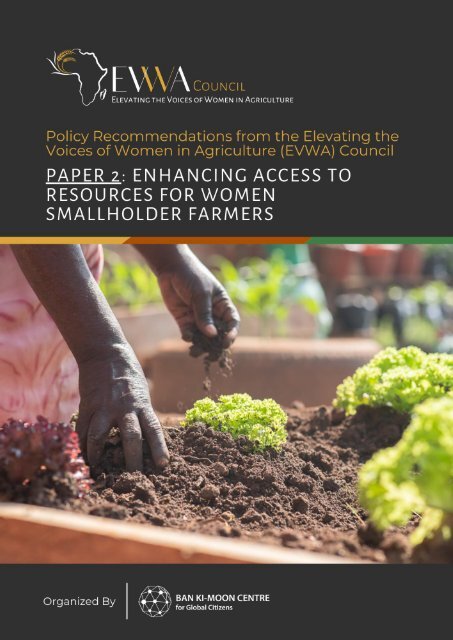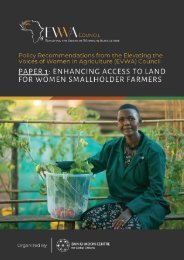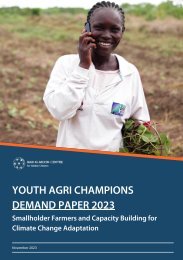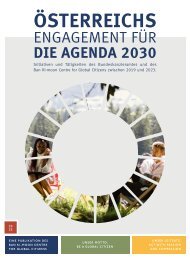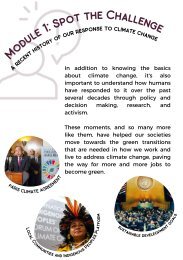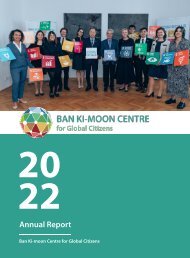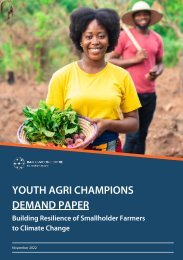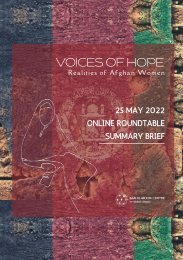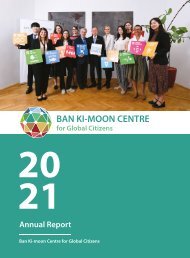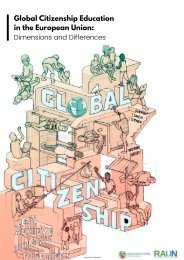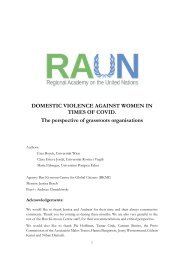EVWA Council Policy Paper 2: Enhancing Access to Resources For Women Smallholder Farmers
The "EVWA Council Policy Paper 2: Enhancing Access to Resources For Women Smallholder Farmers" is the second in a series of three policy papers, produced by the Ban Ki-moon Centre for Global Citizens's EVWA Council together with women smallholder farmers and young changemakers. The paper includes their perspectives in policy recommendations to tackle the main challenges women smallholder farmers face.
The "EVWA Council Policy Paper 2: Enhancing Access to Resources For Women Smallholder Farmers" is the second in a series of three policy papers, produced by the Ban Ki-moon Centre for Global Citizens's EVWA Council together with women smallholder farmers and young changemakers. The paper includes their perspectives in policy recommendations to tackle the main challenges women smallholder farmers face.
Create successful ePaper yourself
Turn your PDF publications into a flip-book with our unique Google optimized e-Paper software.
1
<strong>Policy</strong> Recommendations from the Elevating the Voices of<br />
<strong>Women</strong> in Agriculture (<strong>EVWA</strong>) <strong>Council</strong><br />
<strong>Enhancing</strong> <strong>Access</strong> <strong>to</strong> <strong>Resources</strong> for <strong>Women</strong><br />
<strong>Smallholder</strong> <strong>Farmers</strong>: Recommendations from<br />
the Elevating the Voices of <strong>Women</strong> in<br />
Agriculture (<strong>EVWA</strong>) <strong>Council</strong><br />
In the year 2023, global food insecurity grew by<br />
10%, driven by a combination of conflicts and<br />
climate change. An estimated 238 million<br />
people worldwide now face acute food<br />
insecurity. 1 To curb this trend, we need <strong>to</strong><br />
empower smallholder farmers <strong>to</strong> enhance their<br />
resilience and increase their yields. More<br />
support is required especially for women<br />
smallholder farmers, who grow the majority of<br />
food crops in low- and middle-income<br />
countries. Efforts must be made <strong>to</strong> close gender<br />
productivity gaps; because women have more<br />
difficulty accessing land, resources, and<br />
leadership than men, their average yields per<br />
acre are lower – in some cases up <strong>to</strong> 30<br />
percent. 2<br />
In the previous policy brief, the <strong>EVWA</strong> <strong>Council</strong><br />
provided recommendations <strong>to</strong> enhance<br />
equitable access <strong>to</strong> land. This second brief<br />
focuses on improving women smallholder<br />
farmers’ access <strong>to</strong> resources, <strong>to</strong> grow their yields<br />
and enhance their resilience.<br />
This paper follows UN <strong>Women</strong> and ESCWA’s<br />
definition of the concept ‘access and control<br />
over resources’ 3 – see Box 1.<br />
Resource access patterns and trends vary<br />
greatly between and within countries. This<br />
makes it impossible <strong>to</strong> create a universal<br />
Box 1 – Definition of <strong>Access</strong> and Control<br />
over <strong>Resources</strong> (UN <strong>Women</strong>, ESCWA)<br />
<strong>Resources</strong> refers <strong>to</strong> means and goods, including<br />
economic (household income) or productive<br />
means (land, equipment, <strong>to</strong>ols, work, credit);<br />
political means (capability for leadership,<br />
information and organization); and time.<br />
<strong>Access</strong> and control have slightly different<br />
meanings. <strong>Access</strong> refers <strong>to</strong> the ability <strong>to</strong> use and<br />
benefit from specific resources (material,<br />
financial, human, social, political, etc.) whereas<br />
control over resources also entails being able <strong>to</strong><br />
make decisions over the use of that resource. <strong>For</strong><br />
example, women’s control over land means<br />
that they can access land (use it), own land (can<br />
be the legal titleholders), and make decisions<br />
about whether <strong>to</strong> sell or rent the land. <strong>Access</strong><br />
and control over resources is a key element of<br />
women’s empowerment, and by extension, the<br />
achievement of gender equality.<br />
hierarchy or select the most important<br />
resources women smallholder farmers<br />
everywhere require. Therefore, the <strong>Council</strong><br />
decided <strong>to</strong> use this brief as an opportunity <strong>to</strong><br />
‘zoom out’ and look at women smallholder<br />
1<br />
“Global Food Crises – mid-year update 2023:<br />
hunger and malnutrition levels remain<br />
alarmingly high,” EU Science Hub, European<br />
Commission, accessed April 15, 2024,<br />
https://joint-research-centre.ec.europa.eu/jrcnews-and-updates/global-food-crises-midyear-update-2023-2023-09-15_en<br />
2<br />
World Bank Group, “Gender Gaps in<br />
Agriculture Productivity and Public Spending in<br />
Nigeria,” Nigeria Gender Innovation Lab, 19<br />
September 2023,<br />
https://documents1.worldbank.org/curated/en/<br />
099091823113036874/pdf/P175095086510b00<br />
1080e30d147463456d6.pdf<br />
3<br />
“Term: <strong>Access</strong> and control over resources,” SD<br />
Glossary, UN ESCWA. <strong>Access</strong>ed April 15, 2024,<br />
https://www.unescwa.org/sd-glossary/accessand-control-over-resources<br />
1
farmers’ lives and food crop value chains on and<br />
off the farm.<br />
In discussions on access <strong>to</strong> resources, it is<br />
important <strong>to</strong> consider intersectionality: a<br />
smallholder farmer’s gender is not always the<br />
main fac<strong>to</strong>r that determines their ability <strong>to</strong><br />
access the resources they need. Cultural fac<strong>to</strong>rs,<br />
education, geography, and wealth also play<br />
important roles. In addition, though women on<br />
average have lower access than men <strong>to</strong> almost<br />
all types of resources almost everywhere, access<br />
rates are often very low for both women and<br />
men. <strong>For</strong> example, FAO survey results show that<br />
in Ghana in 2017, the share of male farmers with<br />
access <strong>to</strong> irrigation was slightly higher than that<br />
of female farmers, but still below 3 percent. 4 We<br />
therefore ideally need interventions that<br />
support all smallholder farmers but are gender<br />
transformative; that include a special focus on<br />
women and advance gender equality overall.<br />
Finally, it is important <strong>to</strong> remember that access<br />
<strong>to</strong> resources is not binary. Many studies that<br />
investigate the issue ask yes or no questions <strong>to</strong><br />
gauge farmers’ access <strong>to</strong>, for example, fertilizer.<br />
They do not assess whether farmers have<br />
enough fertilizer <strong>to</strong> meet their needs, or how<br />
difficult, costly, or time-consuming it is <strong>to</strong> access<br />
fertilizer. In addition, most studies investigate<br />
household access <strong>to</strong> resources, differentiating<br />
between male- and female-headed<br />
households. Intra-household dynamics are not<br />
considered, so that women smallholder farmers<br />
in male-headed households remain invisible <strong>to</strong><br />
the statistics. Given the many variables that<br />
influence access <strong>to</strong> resources, better data, and<br />
in particular better sex-disaggregated data, is<br />
needed.<br />
Considering these complexities and the broad<br />
nature of the issue at hand, the <strong>EVWA</strong> <strong>Council</strong><br />
has developed three ‘seedlings’ that may inspire<br />
governments and other stakeholders as they<br />
think through and act <strong>to</strong> advance women<br />
smallholder farmers’ access <strong>to</strong> resources.<br />
Seedling 1: Address buckets of needs<br />
The first seedling proposes the definition of<br />
three ‘Buckets of needs’ <strong>to</strong> guide interventions<br />
<strong>to</strong> advance women smallholder farmers’ access<br />
<strong>to</strong> resources: 1) directly farming-related<br />
resources; 2) infrastructure; 3) knowledge,<br />
agency and time. These buckets are useful as<br />
they highlight the different types of resources<br />
required by farmers. To build lasting resilience,<br />
interventions are needed that address all three<br />
buckets. The buckets also help <strong>to</strong> demonstrate<br />
that women smallholder farmers’ lives must be<br />
considered holistically, as their lives on and off<br />
their farms are closely interwoven. <strong>For</strong> example,<br />
unpaid household work is an important variable<br />
influencing the success of female-led agribusinesses;<br />
time poverty is one of the biggest<br />
constraints on women smallholder farmers<br />
developing new revenue streams.<br />
Bucket 1. Directly farming-related<br />
resources<br />
These are what people tend <strong>to</strong> think of first<br />
when discussing access <strong>to</strong> resources for<br />
farmers: inputs such as improved seeds,<br />
fertilizer, and <strong>to</strong>ols, but also credit. <strong>Access</strong> <strong>to</strong><br />
credit remains low for both male and female<br />
smallholder farmers, but getting loans is more<br />
challenging for women as they are less likely <strong>to</strong><br />
be able <strong>to</strong> provide collateral, such as land. Tools<br />
are often financially out of reach for women<br />
farmers, but may also be physically unsuitable if<br />
they have been designed for the average man.<br />
Even when <strong>to</strong>ols are designed <strong>to</strong> support work<br />
primarily undertaken by women, women are<br />
often not sufficiently engaged or consulted in<br />
the design process.<br />
Bucket 2. Infrastructure<br />
The resources in this bucket tend <strong>to</strong> be<br />
communal and require organisation rather than<br />
empowerment of individual smallholder<br />
farmers. They include energy and water<br />
infrastructure, s<strong>to</strong>rage and processing facilities<br />
4<br />
FAO, The Status of <strong>Women</strong> in Agrifood<br />
Systems. Rome. P.82.<br />
https://doi.org/10.4060/cc5343en<br />
2
<strong>to</strong> reduce post-harvest waste, and finally<br />
transport and markets. Besides directly<br />
supporting farming activities, resources such as<br />
easily accessible water and energy are also very<br />
important <strong>to</strong> free up women’s time for farming<br />
activities by reducing workloads in the<br />
household. It is important <strong>to</strong> remember that<br />
even if communities have infrastructure in<br />
place, women are still more likely <strong>to</strong> be<br />
underserved. Their land may be further away<br />
from water sources, 5 for example, or they may<br />
not be able <strong>to</strong> benefit from electricity as they<br />
lack access <strong>to</strong> appliances.<br />
Bucket 3. Knowledge, agency, and time<br />
The resources in this bucket are the least<br />
tangible of all but serve as important multipliers<br />
for interventions that enhance access <strong>to</strong> the<br />
resources in the other buckets. If women<br />
farmers can access education or extension<br />
services, increase their decision-making<br />
authority over their farms, and invest more time<br />
in farming, their ability <strong>to</strong> access and effectively<br />
use all other resources will improve. Examples of<br />
interventions that address this bucket include<br />
unlocking access <strong>to</strong> market information and<br />
knowledge on prices, <strong>to</strong> help farmers make<br />
smart choices for more lucrative products.<br />
Stakeholders can also support women farmers<br />
and their cooperatives <strong>to</strong> develop their business<br />
and planning skills. Information services such as<br />
weather forecasts can serve as a buffer against<br />
uncertainties. <strong>Women</strong>’s agency and time are<br />
more difficult <strong>to</strong> influence as these are often<br />
determined by deeply ingrained cultural norms.<br />
All stakeholders working with women<br />
smallholder farmers should make sure at the<br />
very least that they do not exacerbate women’s<br />
time poverty, 6 and ideally find entry points <strong>to</strong><br />
advance gender equality more generally, at the<br />
household and community levels.<br />
Seedling 2: Strengthen value chains<br />
This seedling provides an alternative way <strong>to</strong><br />
organise interventions <strong>to</strong> the ‘buckets’<br />
described above. It proposes a focus on<br />
resources required for post-harvest processing<br />
and access <strong>to</strong> markets, as these are ultimately<br />
the most important for growing incomes and<br />
thereby resilience <strong>to</strong> climate change and other<br />
shocks. The proposal is <strong>to</strong> focus on chains:<br />
• Food crop value chains: Whereas value<br />
chains for commodity crops 7 , primarily<br />
grown and sold by men, tend <strong>to</strong> be welldeveloped<br />
and formalised, value chains for<br />
food crops 8 often are not, despite their<br />
importance for food security. This leads <strong>to</strong><br />
underinvestment in food crop cultivation,<br />
which is dominated by women farmers.<br />
• ‘Resource needs chains’: <strong>For</strong> example, in<br />
order <strong>to</strong> purchase machinery, women first<br />
need <strong>to</strong> access credit. To access credit, they<br />
need <strong>to</strong> build the financial literacy <strong>to</strong> write<br />
good loan applications. They also need<br />
access <strong>to</strong> markets so that they can generate<br />
the income <strong>to</strong> repay the loan. Therefore,<br />
interventions that provide access <strong>to</strong><br />
machinery without also addressing<br />
financial literacy, access <strong>to</strong> markets and<br />
access <strong>to</strong> credit are likely <strong>to</strong> be less effective<br />
than those that consider resource needs<br />
chains.<br />
Ultimately, the goal is <strong>to</strong> help women regard<br />
agriculture as a business rather than a<br />
5<br />
ActionAid International. What <strong>Women</strong> <strong>Farmers</strong><br />
Need: A Blueprint for Action. The Hague, 2011.<br />
https://actionaid.org/sites/default/files/the_blu<br />
e_print_for_women_farmers.pdf<br />
6<br />
E.g. Bain, Ransom and Halimatusa’diyah<br />
(2018) found that though interventions that<br />
provided women farmers in Uganda with dairy<br />
cows led <strong>to</strong> higher incomes and enhanced<br />
nutritional security, many women struggled <strong>to</strong><br />
combine care for their cows (especially<br />
accessing enough clean water) with their other<br />
duties. Bain, C., Ransom, E. and<br />
Halimatusa’diyah, I., “Weak winners’ of<br />
<strong>Women</strong>'s empowerment: The gendered effects<br />
of dairy lives<strong>to</strong>ck assets on time poverty in<br />
Uganda,” Journal of Rural Studies, 61 (July<br />
2018): pp.100-109.<br />
https://doi.org/10.1016/j.jrurstud.2018.03.004<br />
7<br />
Commodity crops are crops primarily destined<br />
for sale/export, such as coffee, tea, sugar cane,<br />
cocoa, cot<strong>to</strong>n, <strong>to</strong>bacco, etc.<br />
8<br />
Food crops are crops primarily destined for<br />
local or regional consumption, such as<br />
vegetables, fruits, grains, legumes, etc.<br />
3
subsistence activity. Experience has shown that<br />
this mindset change can lead <strong>to</strong> better<br />
decision-making and higher yields. Another<br />
promising approach is <strong>to</strong> build more direct<br />
linkages between women farmers and market<br />
buyers, and make the value chain visible <strong>to</strong><br />
both. <strong>For</strong> example, LadyAgri connects womenled<br />
SME buyers (e.g. shops, food businesses) <strong>to</strong><br />
women farmer cooperatives. Stakeholders<br />
should analyse what else is needed <strong>to</strong> improve<br />
access <strong>to</strong> markets (Better s<strong>to</strong>rage? Better<br />
knowledge of when <strong>to</strong> s<strong>to</strong>re and when <strong>to</strong> sell?<br />
Better transport?) and address these resource<br />
needs as a priority.<br />
Whereas the first seedling sought <strong>to</strong> bring focus<br />
<strong>to</strong> women’s lives on and off their farms, this<br />
seedling highlights women’s roles not only at<br />
pre-harvest but also at post-harvest stages of<br />
production, and seeks <strong>to</strong> empower women as<br />
key economic ac<strong>to</strong>rs. <strong>Women</strong> already<br />
undertake the majority of primary sorting and<br />
processing work for both food and commodity<br />
crops. Adding value <strong>to</strong> local food crops can<br />
bring visibility <strong>to</strong> the advantages of women’s<br />
entrepreneurship and increase their access <strong>to</strong><br />
productive resources such as land. It will also<br />
lead <strong>to</strong> greater food production and improved<br />
food security. Finally, underlining women’s<br />
value and contribution <strong>to</strong> community<br />
wellbeing, nutrition and resilience builds<br />
momentum <strong>to</strong> increase women’s access <strong>to</strong><br />
further resources and increase yields.<br />
Seedling 3: Change the game<br />
The third seedling pinpoints some potential<br />
game changers that help women <strong>to</strong> tap in<strong>to</strong><br />
new opportunities.<br />
The first game changer identified is collective<br />
action: when women work <strong>to</strong>gether, they are<br />
able <strong>to</strong> unlock opportunities that are otherwise<br />
inaccessible. <strong>Women</strong>’s savings groups have for<br />
decades provided quick credit <strong>to</strong> women<br />
smallholder farmers unable <strong>to</strong> access financing<br />
elsewhere. However, the amounts they are able<br />
<strong>to</strong> provide are not sufficient <strong>to</strong> facilitate climate<br />
change adaptation or the purchase of<br />
technology for agri-businesses, and new forms<br />
of collaboration must be found.<br />
Good examples include the LadyAgri Pépites<br />
Programme in Guinea, 9 which builds womenowned<br />
business clusters along agricultural<br />
value chains. It has supported 200 SME’s,<br />
connecting women across the rural-urban<br />
divide, strengthening community sharing skills,<br />
and building a strong network working under<br />
the collective identity ‘Pépites'. Pépites as a<br />
collective is a significant economic force, which<br />
has managed <strong>to</strong> pique the interest of service<br />
providers, the government, and the financial<br />
sec<strong>to</strong>r in a way that individual farmers are<br />
unable <strong>to</strong>.<br />
Digital solutions can also change the game by<br />
facilitating instant access <strong>to</strong> information,<br />
connections, and organisation where this was<br />
previously impossible, particularly for women in<br />
rural areas. <strong>For</strong> example, the Digital Agriculture<br />
for Accelerated and Inclusive Post-Covid 19<br />
Recovery Project 10 in Laikipia County, Kenya,<br />
increases access <strong>to</strong> and utilisation of digital<br />
agricultural content for sustainable agriculture<br />
and food security. The LadyAgri SAFAF<br />
programme, co-financed by the European<br />
Union, is a national food security programme<br />
that helps women engage with the national<br />
market information system, has established an<br />
e-commerce platform, enhances access <strong>to</strong><br />
finance and builds farm-<strong>to</strong>-fork business<br />
clusters along agricultural value chains. Another<br />
example is the CGIAR Initiative on Digital<br />
Innovation. This initiative simultaneously<br />
addresses the supply and demand sides for<br />
9<br />
LadiAgri Investment Hub. LadyAgri Annual<br />
Report 2021-2022. <strong>Access</strong>ed 18 April 2024,<br />
https://assets-global.websitefiles.com/5e6519c2af4002071aa3e753/62bb01<br />
3de08029250a1eada7_EN_Annual%20Report%<br />
202022_compressed.pdf<br />
10<br />
The<br />
African Centre for <strong>Women</strong>, Information and Co<br />
mmunications Technology (ACWICT) is a Kenyabased<br />
ICT for Development (ICT4D)<br />
Organization, with a regional reach whose<br />
mission is <strong>to</strong> promote women and youth access<br />
<strong>to</strong> and knowledge of ICTs as <strong>to</strong>ols. See “About<br />
Us,” ACWICT, accessed 18 April 2024,<br />
https://www.acwict.org/about-us/<br />
4
agricultural information services aimed at<br />
smallholder farmers. It undertakes research and<br />
innovation efforts <strong>to</strong> develop improved,<br />
gender-responsive information services, while<br />
also supporting digital skills development<br />
among smallholder farmers and enhanced<br />
access <strong>to</strong> digital technologies and networks. 11 A<br />
specific example of impact achieved is the<br />
Initiative’s collaboration with Farm Radio<br />
International (FRI), which supports over 700<br />
radio shows in 40 African countries. To allow FRI<br />
<strong>to</strong> provide more locally relevant information,<br />
farmers can call in <strong>to</strong> a free number and record<br />
responses <strong>to</strong> open-ended questions. However,<br />
manually analysing the thousands of responses<br />
received proved difficult and time consuming.<br />
In response <strong>to</strong> this challenge, CGIAR and FRI<br />
developed an au<strong>to</strong>mated system which uses<br />
artificial intelligence <strong>to</strong> analyse voicemails<br />
quickly and efficiently, thus unlocking a huge<br />
reposi<strong>to</strong>ry of farmer’s knowledge and<br />
perspectives. 12<br />
be available <strong>to</strong> help grow their reach and<br />
impact.<br />
Conclusion<br />
As this paper shows, access <strong>to</strong> resources for<br />
women smallholder farmers is a large and<br />
complex issue, the nuances of which vary<br />
greatly between different countries,<br />
communities and even households. During the<br />
discussions in the <strong>EVWA</strong> <strong>Council</strong>, it became<br />
evident that it is often the programmes that<br />
provide intensive, personal, long-term<br />
guidance <strong>to</strong> a small number of farmers that<br />
manage <strong>to</strong> make a lasting difference. Such<br />
projects do not only help women farmers<br />
access all the resources along their ‘resource<br />
needs chains’, but also support women’s<br />
empowerment and gender equality overall. As<br />
they require individual coaching and the<br />
building of trust, they are difficult <strong>to</strong> scale<br />
rapidly and therefore unlikely <strong>to</strong> make<br />
headlines. However, new digital solutions may<br />
11<br />
“Initiative: Digital Innovation,” CGIAR<br />
Research Initiatives, CGIAR. <strong>Access</strong>ed 18 April<br />
2024. https://www.cgiar.org/initiative/digitalinnovation/?section=about.<br />
12<br />
“INITIATIVE RESULT: Artificial intelligence<br />
enables extension services reaching 12 million<br />
farmers in sub-Saharan Africa <strong>to</strong> respond <strong>to</strong><br />
farmers’ voices,” CGIAR Research Initiatives,<br />
CGIAR. <strong>Access</strong>ed 18 April 2024,<br />
https://www.cgiar.org/initiative-result/artificialintelligence-enables-extension-servicesreaching-12-million-farmers-in-sub-saharanafrica-<strong>to</strong>-respond-<strong>to</strong>-farmers-voices/.<br />
5
Key resources on women’s access <strong>to</strong> <strong>Resources</strong><br />
The following literature was used in the preparation of the <strong>EVWA</strong> <strong>Council</strong> discussions and the<br />
development of this paper:<br />
ActionAid International. 2011. What <strong>Women</strong> <strong>Farmers</strong> Need: A Blueprint for Action. The Hague.<br />
https://actionaid.org/sites/default/files/the_blue_print_for_women_farmers.pdf<br />
Ajadi, A.A., Oladele, O.I., Ikegami, K. and Tsuruta, T., 2015. Rural women’s farmers access <strong>to</strong> productive<br />
resources: the moderating effect of culture among Nupe and Yoruba in Nigeria. Agriculture &<br />
Food Security (2015) 4:26. DOI 10.1186/s40066-015-0048-y<br />
Anaglo, J.N., Boateng, S.D. and Boateng, C.A., 2014. Gender and <strong>Access</strong> <strong>to</strong> Agricultural <strong>Resources</strong> by<br />
<strong>Smallholder</strong> <strong>Farmers</strong> in the Upper West Region of Ghana. Journal of Education and Practice 5:5.<br />
Ankrah, D.A., Freeman, C.Y. and Afful, A., 2020. Scientific African 10.<br />
https://doi.org/10.1016/j.sciaf.2020.e00604<br />
Bain, C., Ransom, E., and Halimatusa'diyah, I., 2018. ‘Weak winners’ of <strong>Women</strong>'s empowerment: The<br />
gendered effects of dairy lives<strong>to</strong>ck assets on time poverty in Uganda. Journal of Rural Studies,<br />
61. https://doi.org/10.1016/j.jrurstud.2018.03.004.<br />
Dwomoh et al., 2023. Modeling inequality in access <strong>to</strong> agricultural productive resources and<br />
socioeconomic determinants of household food security in Ghana: a cross‐sectional study.<br />
Agricultural and Food Economics (2023) 11:24. https://doi.org/10.1186/s40100-023-00267-<br />
6.<br />
European Union Joint Research Centre, 2023. Global Food Crises – mid-year update 2023: hunger and<br />
malnutrition levels remain alarmingly high. https://joint-research-centre.ec.europa.eu/jrcnews-and-updates/global-food-crises-mid-year-update-2023-2023-09-15_en<br />
Fashogbon, A. E., Morrison, L.E., Sahay, A., and Vaillant, J., 2023. Gender Gaps in Agriculture Productivity<br />
and Public Spending in Nigeria (English). Nigeria Gender Innovation Lab Washing<strong>to</strong>n, D.C.:<br />
World Bank Group. http://documents.worldbank.org/curated/en/099091823113036874/<br />
P175095086510b001080e30d147463456d6<br />
Food and Agriculture Organization of the United Nations, 2023. The status of women in agrifood<br />
systems. https://www.fao.org/3/cc5343en/cc5343en.pdf.<br />
GSMA, 2022. Reaching and Empowering <strong>Women</strong> with Digital Solutions in the Agricultural Last Mile.<br />
https://www.gsma.com/mobilefordevelopment/wp-content/uploads/2022/05/Agri-<strong>Women</strong>in-Value-Chains-v5.pdf.<br />
Murray, U., Gebremedhin, Z., Brychkova, G., Spillane, C., 2016. <strong>Smallholder</strong> farmers and climate smart<br />
agriculture: technology and labor-productivity constraints amongst women smallholders in<br />
Malawi. Gend. Technol. Dev. 20 (2), 117–148.<br />
Njuki et al., 2022. A review of evidence on gender equality, women’s empowerment, and food systems.<br />
Global Food Security 33. https://doi.org/10.1016/j.gfs.2022.100622.<br />
Okolo, W., 2021. Optimizing Farm Systems Through Gender Inclusion: Leveraging agricultural service<br />
delivery.<br />
Pauw, K., 2021. A review of Ghana’s planting for food and jobs program: implementation, impacts,<br />
benefits, and costs. Food Security (2022). https://doi.org/10.1007/s12571-022-01287-8<br />
Theriault, V., Smale, M., Haider, H., 2017. How does gender affect sustainable intensification of cereal<br />
production in the West African Sahel? Evidence from Burkina Faso. World Dev. 92 (April), 177–<br />
191.<br />
6


